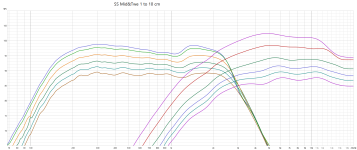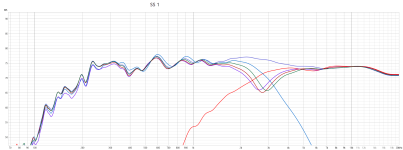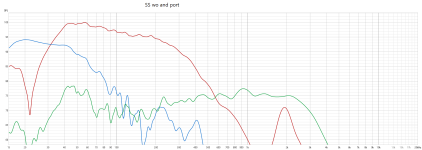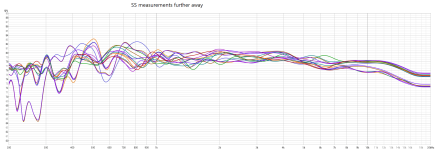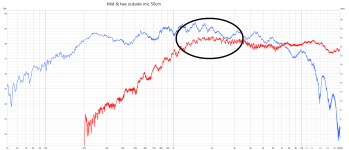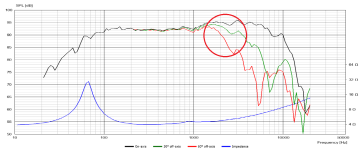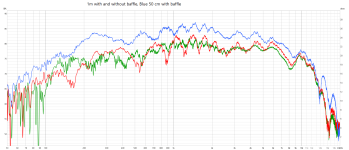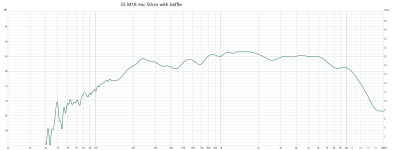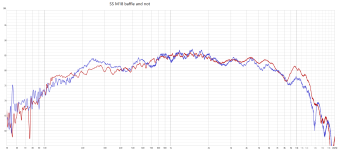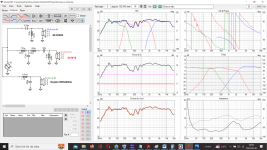We need more basic information like, responses of individual drivers with your xo. if you can't mute other drivers and use same mic position, take nearfield measurements by placing the mic 1cm from the driver membrane (use lower signal level to prevent clipping in mic) From this you can see if response is basically ok and possible in-box resonances.These don't show baffle step or edge interferences!
Then move the mic to about 50cm from drivers, mic height at intended design axle. Mute the bass, play both drivers individually and together. Then change polarity of mid or tw and measure m+t together again. After taking these, toggle "All spl" to see overlay of these. This way you see acoustic responses and summation of individual drivers.
Room and other reflections start making changes in a measurement below 1kHz typically in indoor measurements. So, low end of the mid and bass measurements for xo integration analysis should be done outdoors. As you have noticed, playing with windowing settings, CSD settings, smoothing etc. don't help much.
Below my measurents, just different windowing and smooting settings. Measured indoors 60cm from a WWMT tower active speaker with Hypex FA123 dsp-amp. This was not the final version...
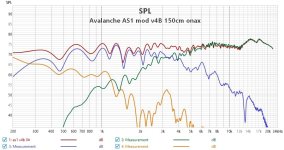
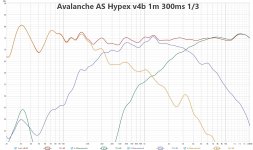
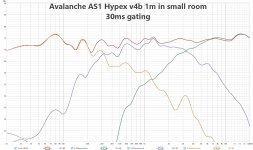
and near listening spot using handheld mic at several positions (different version of dsp settings).
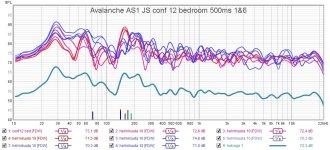
and nearfield vs. 1m of the mid with dsp
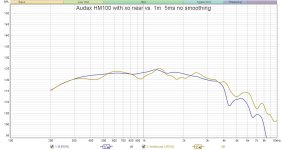
Then move the mic to about 50cm from drivers, mic height at intended design axle. Mute the bass, play both drivers individually and together. Then change polarity of mid or tw and measure m+t together again. After taking these, toggle "All spl" to see overlay of these. This way you see acoustic responses and summation of individual drivers.
Room and other reflections start making changes in a measurement below 1kHz typically in indoor measurements. So, low end of the mid and bass measurements for xo integration analysis should be done outdoors. As you have noticed, playing with windowing settings, CSD settings, smoothing etc. don't help much.
Below my measurents, just different windowing and smooting settings. Measured indoors 60cm from a WWMT tower active speaker with Hypex FA123 dsp-amp. This was not the final version...



and near listening spot using handheld mic at several positions (different version of dsp settings).

and nearfield vs. 1m of the mid with dsp

Last edited:
I think in Jawen's case it is remarkable that he has stuck with his designs and not given up with responding to our questions.
Just like all people as we go through life, work, hobbies and pastimes we are continuously learning.
Really precise loudspeaker design is a never ending story, and look at the number of critiques there are of successful commercial designs, but they still sell in the 100's if not 1000s worldwide.
In the beginning we all start with a simple design, it sounds great, possibly we carry on tuning it by ear until it really sings. We live with for years, and then we change something, and we start wondering about the speakers.
The point is that this first design may give many years of enjoyment, and will be fondly remembered.
Some time later with lots of reading, visiting forums, going to the shows or enthusiast get togethers, we progress with a new hopefully better design, based on what we need. We spend the cost of a small loudspeaker on test equipment and hopefully donate when we can for software
Modelling software and good measurements helps us achieve a predicted outcome. The final stage of getting the measured data to match the modelled data, or vice versa can be one of the most time consuming aspects and can be a pain. Some times a combination that should be good with information from the data sheets doesn't quite come together which can be frustrating.
Jawen, because of the pain you are in at the moment, is it the fact that the measurements "The Wiggle" can be seen and doesn't look as smooth as you hoped, and you could hear this before the measurement, or only after measuring it has become an annoyance?
If they sound great to you and they fulfil your design goals, you like it loud, possibly you are done and the jobs a good un.
Just like all people as we go through life, work, hobbies and pastimes we are continuously learning.
Really precise loudspeaker design is a never ending story, and look at the number of critiques there are of successful commercial designs, but they still sell in the 100's if not 1000s worldwide.
In the beginning we all start with a simple design, it sounds great, possibly we carry on tuning it by ear until it really sings. We live with for years, and then we change something, and we start wondering about the speakers.
The point is that this first design may give many years of enjoyment, and will be fondly remembered.
Some time later with lots of reading, visiting forums, going to the shows or enthusiast get togethers, we progress with a new hopefully better design, based on what we need. We spend the cost of a small loudspeaker on test equipment and hopefully donate when we can for software
Modelling software and good measurements helps us achieve a predicted outcome. The final stage of getting the measured data to match the modelled data, or vice versa can be one of the most time consuming aspects and can be a pain. Some times a combination that should be good with information from the data sheets doesn't quite come together which can be frustrating.
Jawen, because of the pain you are in at the moment, is it the fact that the measurements "The Wiggle" can be seen and doesn't look as smooth as you hoped, and you could hear this before the measurement, or only after measuring it has become an annoyance?
If they sound great to you and they fulfil your design goals, you like it loud, possibly you are done and the jobs a good un.
Last edited:
Thanks for educating answer Juhazi 👍We need more basic information like, responses of individual drivers with your xo
I will try to do the measurements you mention today, and also post i here later.
BTW: I love the sound from Audax hm100z0 and hm130z0, they are "top class" for me 👍
Just like all people as we go through life, work, hobbies and pastimes we are continuously learning.
True fine words Ray!
Every word you wrote is about life, the drive, the curiosity, the conditions, the expectations, the upbringing, the demands on yourself and to continue to be humble.
And in speaker-building i find it real hard to come to an "end" regarding the xover.
I want as much microdetails as possible, but can´t stand "in your face" sound or nor the least bit of "sharp sound" up in frequency (my ear´s wants to fold up and listening fatigue comes real fast)
best regards John
Okey, her comes first serie of measurements on tweeter and midrange with xovers.We need more basic information like, responses of individual drivers with your xo
I measure both separately from 1, 2, 4, 6, 8 and 10 cm, with other drivers possetive cable dissconnected.
You can se that both drivers get "better" from mic 6 cm and further away, and also maby my crossing-point a little high.
Real interesting!
Will measure mid & twe together now and also woofer and port.
Attachments
do you get a flat frequency and phase response with a physical loopback check?
That's perhaps impossible to test with this system.
if the setup/calibration of the measuring system has not been verified by some means, why would anyone proceed using this measuring system?
Here is measurements on tweeter and mid, separate, together and twe out of phase all is mic from 50 cm.
The 3 measurements with out of phase have small differances because i made a test lowering the mic a few cm. (real hard to se if mic i exact between twe and mid and i have separate boxes for them)
The 3 measurements with out of phase have small differances because i made a test lowering the mic a few cm. (real hard to se if mic i exact between twe and mid and i have separate boxes for them)
Attachments
I have a calibrated mic 👍if the setup/calibration of the measuring system has not been verified by some means, why would anyone proceed using this measuring system?
Okey now measurements from the woofer and port, mic at 2 cm. (port=Blue, woofer=Red, woofer/mid=Green)
And woofer and mid, mic from ca 50 cm and ca cc woofer/mid.
All data from same sound level on the measurements
Now more understand that if you want "more correct data" on your woofer/woofer-low midrange measurements, you have to go outdoors.
Even if me myself still thinks that a few different measurements & using your hearing & feeling go a long way.
But if i was a company producing and selling speakers, of course i want to show best measurements possible (but that is a different thing)
Tell me if you want to see other combinations of measurements on the same screen with overlays 👍
best regards John
And woofer and mid, mic from ca 50 cm and ca cc woofer/mid.
All data from same sound level on the measurements
Now more understand that if you want "more correct data" on your woofer/woofer-low midrange measurements, you have to go outdoors.
Even if me myself still thinks that a few different measurements & using your hearing & feeling go a long way.
But if i was a company producing and selling speakers, of course i want to show best measurements possible (but that is a different thing)
Tell me if you want to see other combinations of measurements on the same screen with overlays 👍
best regards John
Attachments
In the end, final crossover tuning is often still done by ear. You get the quasi-anechoic measured result reasonably flat with the cleanest measurements you can create, then you listen, adjust, measure, listen, adjust, etc. It is common for this to stretch over multiple days at a minimum.And in speaker-building i find it real hard to come to an "end" regarding the xover.
I want as much microdetails as possible, but can´t stand "in your face" sound or nor the least bit of "sharp sound" up in frequency (my ear´s wants to fold up and listening fatigue comes real fast)
It can be helpful to compare to known good speakers or headphones also, so you are less likely to wind up wandering around in the weeds. If you can quickly switch back and forth to compare it can make some errors obvious. It's easy to get lost in your adjustments, since your ears get used to frequency imbalances pretty quickly and they also get tired. After 30 minutes or so of serious listening like this, you typically need a break.
Average ears are most sensitive around the same region you have a slight (but broad) peak in response in the measurement below. If your current configuration is leaning toward listening fatigue, you may want to decrease the circled region. Some designs intentionally decrease this below flat so they can be listened to at higher levels without inducing fatigue. But this region also impacts the sensation of dynamics/liveness, so it's fussy if you want detail but are prone to fatigue. I use an old analog graphic equalizer to test changes like this, since it's easy and gives instant feedback. When the change is positive, I'll then incorporate it into the crossover.
I also think you're making good progress. Measuring accurately in a home environment is not easy, and it takes knowledge of a lot of details that just aren't obvious when you start from zero. It does get easier over time though, and understanding the limitations becomes second nature. Which is also why it can be hard to explain. Once you know the intricacies you don't really think about them thoroughly on a day-to-day basis.I think in Jawen's case it is remarkable that he has stuck with his designs
Average ears are most sensitive around the same region you have a slight (but broad) peak in response in the measurement below
Totaly agree 👍
But it "disappears" when i measure further away? (here is 15+ measurement)
Thank you 🙂I also think you're making good progress.
regards John
Attachments
Thanks for pointing that out. I missed the distance.it "disappears" when i measure further away?
Measurement anomalies can happen when the microphone is too close to a multi-way speaker. For typical speaker designs, "too close" changes based primarily on driver spacing and crossover slope. The larger the spacing and the more shallow the slope, the more distance you typically need for proper integration of the individual drive units' outputs.
👍the more distance you typically need for proper integration of the individual drive units' outputs.
My taste/belive is that, there must always be a certain distance between the speaker and the listener.
Big powerfull speaker need often at least 4 m for a 3-4-way"to blend in"properly regarding the "soundwave/energy"
Especially when you listning at +100 dB.....Lots of energy flows out from the speaker and all that energy "need" to be "mixed up" with the air between the speaker and the listener.
Hej, looking good!
I'm not at home now, can't respond better until Monday!
mattstat's comments are good, thank you.
400-800Hz wiggles are artefacts!
A bit elevated on-axis response 1-2 kHz might be compensated in off-axis because of directivity of the mid.
I'm not at home now, can't respond better until Monday!
mattstat's comments are good, thank you.
400-800Hz wiggles are artefacts!
A bit elevated on-axis response 1-2 kHz might be compensated in off-axis because of directivity of the mid.
Good progress here! I’m pretty certain the original 400-800Hz wiggle was a floor bounce interference. The midrange near field doesn’t show it. It seems the system response shows a downward slope up to higher frequencies. Is that meant to be? Furthermore, the mid to high crossover could probably be improved as is said.
Thanks !Good progress here! I’m pretty certain the original 400-800Hz wiggle was a floor bounce interference. The midrange near field doesn’t show it. It seems the system response shows a downward slope up to higher frequencies. Is that meant to be? Furthermore, the mid to high crossover could probably be improved as is said.
Yes the 4-800 hz wiggle on measurements was "strange" for me, because i didn't experience anything strange when I critically listened to music.
The SS M18 is a little "hard" to get to a "perfect" LP slope with, and i shows up in measurements outside even without xover. (se pic)
And when i "damping" that hz-area in the xover, dB also falls back to 700 hz 1-2 dB. (and i really don´t want SPL to drop anything more then what bafflestep does)
Maby my well-stuffed 4 liter mid-box "doesn´t help me" regarding to LP slope "irregularities" or what to call it.
But even if you look at manufacturer Scan Speak's own specs, you se that something "going on" in that area.
So maby you have to cross it little lower or accept 1-2 dB lost in sensivty.
regards John
Attachments
I don’t know your crossover topology. But you can’t correct the baffle step of such small enclosures without knowing exactly what it does and using appropriate circuitry. Iow using the standard solution with a (too big) series coil doesn’t work.
Here is outside measurement from 50 cm with balle= BlueI don’t know your crossover topology. But you can’t correct the baffle step of such small enclosures without knowing exactly what it does and using appropriate circuitry. Iow using the standard solution with a (too big) series coil doesn’t work.
And from 1 meter with and without baffle = Red is with baffle and Green is without.
And xover look like this at the moment.
regards John
Attachments
Could you please post the driver impedance curves (in situ of course…)? The midrange response looks a bit weird to me.
I’m pretty certain the original 400-800Hz wiggle was a floor bounce interference. The midrange near field doesn’t show it
if brown trace is 1cm, this shows the resp of driver w/o baffle effect - it is quite flat 200-2k
whereas if blue trace is 10cm, the dip has appeared
farfield gated test is needed on mid box, which should be raised up (>1m) to be out of "floor bounce" issues
(if bass box is heavy too raise, replace it with a flat baffle of similar size)
I interpreted it this way: the lower the curve, the bigger the measurement distance… a bit of clarification would be welcome.if brown trace is 1cm
- Home
- Loudspeakers
- Multi-Way
- 4-800 Hz wiggle i my 3 way diy
